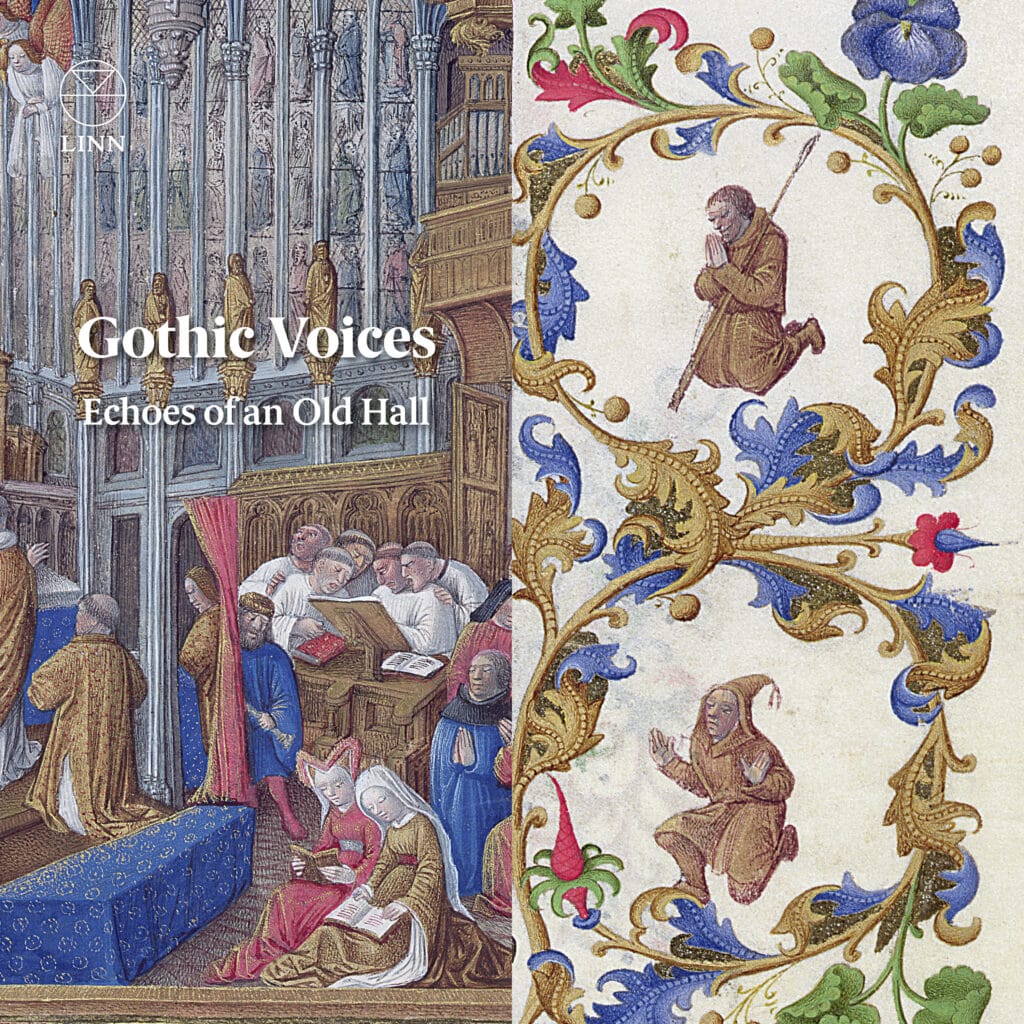10 Jun Glowing review of our new Echoes CD – Recommended
“The performance is splendid with not a hint of Gothic Voices handling the music with kid gloves. They really let rip.” Music Web International
Echoes of an Old Hall
Music from the Old Hall Manuscript
Gothic Voices
rec. 27-30 October 2018, Boxgrove Priory, Chichester, UK
Texts and translations included
Reviewed as downloaded from press preview
LINN CKD644 [76:03]

This splendid CD is, in form, rather like a call and response. The call takes the form of pieces from the Old Hall manuscript, a beautifully illuminated tome that houses the most important collection of English music from the late 14th and early 15th centuries. The response is formed of music inspired by this so-called English style or “Contenance angloise” (so called as not all the composers were English as evidenced by the Old Hall piece by the French composer, Mayshuet de Joan which opens the recording). Gothic Voices use the resonant word Reverberances for the second half of their programme. One of the many joys of this programme is hearing how that influence flowered over the course of the next generation of composers. Dufay is the best known of that next generation, and it is fascinating to hear his influences made so gloriously audible.
Most, but not all, of the works featured here are liturgical and, if there is a secondary unifying theme to the recording, it is that of the feminine. Given that theme and the nature of late medieval piety that means the Virgin Mary figures prominently. An intriguing game of chicken and egg is played out toward the end of the second section where we are left to puzzle out whether the secular chansons were influenced by the more florid top-line-led church music or the other way round. I am no scholar and I bow to Julian Podger’s excellent liner notes which state that, intriguingly, the influence was from the sacred to the secular.
The first half pairs sections of the mass with settings of words in praise of Mary. These Marian compositions have been chosen to reflect the nature of the section of the mass they have been paired with. As Podger puts it: “Joy in Mary’s mercy and the Gloria; celebrating Mary’s heavenly nature and the Sanctus; more sombre faith in her mercy and the Agnus Dei.” I found this added emotional depth to proceedings, not least because the tone of the compositions directed toward Mary tends to be more personal.
There is an additional appropriateness to this way of arranging things in that the Old Hall manuscript is not arranged in the form of complete masses but by section. All of the Glorias are grouped together, all the settings of the Sanctus in a group and so on. This, in itself, is highly suggestive of the liturgical use made of this tome: that the selection of music was rather pick and mix, as it is today in modern church services.
In his review of an earlier Gothic Voices release, Mary, Star of the Sea from 2015 (CKD541 – review: Recording of the Month – review), Gary Higginson notes that over their thirty years in existence in one form or another, either on Hyperion or, more recently on Linn, the ensemble have grown more relaxed in their performance style. That is in ample evidence here. That is not to suggest in any way that standards have slipped. On the contrary, they display the easy nonchalance of true virtuosi. The rhythmical approach to the opening track demonstrates what I mean perfectly. There is not a hint of stiffness. And only a singer steeped in this music could attempt the almost improvisatory freedom of Catherine King’s Gregorian chant on track two.
So instead of excited discovery, feeling their way into the music, what we get is sublime confidence and, above all, a deep sense of love for this music.
The Hilliard Ensemble have recorded an album exclusively devoted to the Old Hall manuscript (7 CDs, budget price, Erato 9029582507) and that provides a basis for comparison, though the Gothic Voices programme is intended to demonstrate something different about this wonderful music. The Hilliards sound considerably more austere than Gothic Voices. Partly it is a matter of vocal timbre, partly that the varied acoustics in which Gothic Voices are recorded are less sepulchral and more intimate. The Hilliards lack the rhythmical spring I mentioned earlier, though their more severe approach is very powerful.
All the music here is recorded without instruments but the variety of music included, the skill with which the programme has been put together and above all the subtle imagination of the performances and the production, mean that there is no hint of longueurs.
Predictably, the second half which features music by Binchois and Lymburgia alongside Dufay, is richer in texture but that very richness has an effect on repeated listening of illuminating (if you will pardon the pun) the earlier music. I particularly enjoyed the rhythmic vibrancy of the Gothic Voices’ approach to the earlier music. It is not aggressive in any way. Buoyant is the word that comes to mind.
The second half comes full circle with a setting of the Gloria by Pychard from the Old Hall collection which quite magnificently pulls together all the threads of this project. I imagine that this superb, ripe setting was the automatic choice to conclude the disc. The performance is splendid with not a hint of Gothic Voices handling the music with kid gloves. They really let rip.
If a much earlier Gothic Voices recording, A Feather on the Breath of God, caught the imagination of the public in 1985 (Hyperion CDA66039: 5-star review – Hyperion Top 30), then this collection, in its more robust way, seems to me perfectly tuned to the musical and perhaps even spiritual needs of 2021. I hope it sells as well as that collection did. It certainly deserves to!
David McDade
